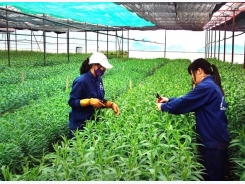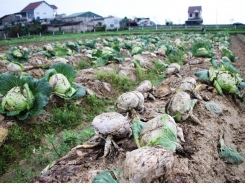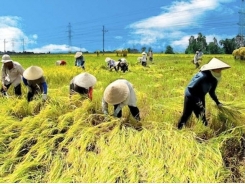Seminar talks fruit, veg exports

A mango garden in Hậu Giang Province. Việt Nam’s fruit and vegetable exports are expected to top US$4.5 billion by 2020. — VNS Photo
Ho Chi Minh City — Việt Nam’s fruit and vegetable exports are expected to top US$4.5 billion by 2020, with fruits accounting for $3.6 billion, according to the Crop Production Department.
Speaking at a seminar on the potential and development orientation of horticulture and floriculture in Việt Nam, Nguyễn Hồng Sơn, director of the department, said Việt Nam’s varied geographic and climatic conditions have allowed it to diversify its fruit and vegetable production, giving it great export potential.
The area under fruits, productivity and output have gone up significantly in the past 15 years. Banana is grown on the largest area followed by mango, longan, litchi, grapefruit, dragon fruit, pineapple, durian, lemon, rambutan, jackfruit, custard apple, tangerine, and guava.
According to Sơn, 80 per cent of the output is sold in the domestic market as fresh fruits mainly through traditional channels.
Fruit and vegetable exports increased from $151.5 million in 2003 to $1.07 billion in 2013 and $3.52 billion last year, with fruit export accounting for 80 per cent of total export.
China is Việt Nam’s biggest importer (accounting for more than 70 per cent of the latter’s exports), followed by the US, South Korea, Japan, the Netherlands, Malaysia, Taiwan, Thailand, Singapore, and Australia.
There are now “concentrated production areas” for mango, dragon fruit, litchi, grape, grapefruit and others as well as for flowers, many of which adopt good agricultural practices like VietGap and GlobalGap and advanced technologies to improve productivity and quality.
But fruit and vegetable farming still faces many problems like small scale and scattered cultivation, inconsistent quality, impacts of climate change, poor harvest and post-harvest technologies, increasing competition in the global market and lack of linkages between businesses and farmers.
“A lack of diversity in fruit exports (dragon fruit accounts for 60 per cent of fruit exports) and a reliance on the Chinese market is another problem,” he said.
Dr Nguyễn Hữu Đạt, general secretary of the Việt Nam Fruits and Vegetables Association, said: “Demand for fresh fruits will continue to increase both in the domestic and overseas markets.”
Challenges and difficulties would “force Việt Nam’s fruit and vegetable production sector to improve quality, meaning they must ensure consistent quality and year-round supply and meet hygiene and food safety standards.”
Businesses must work to increase exports to fastidious markets and join hands for trade promotion in foreign markets to gradually penetrate distribution systems there, he said.
He also said businesses needed to develop close links with farmers so that the latter grew products that met the demand in global markets.
Fruit processing
Sơn said the country had more than 145 industrial-scale vegetable and fruit processing plants with a total capacity of 800,000 tonnes a year besides thousands of smaller ones.
The plants ran at just 50 per cent of capacity due to a shortage of raw materials, he said.
Matthias Ehrtmann, division manager - food and pharma machinery at Rieckermann, HCM City, said last year exports of fruits and vegetables exceeded even that of rice.
“The potential is tremendous.
“However, only about 10 per cent of fruits and vegetables is actually processed into higher-value products,” he said.
Sơn said the country would continue to expand areas under key fruits like banana, mango, orange, pineapple, and longan to serve both exports and domestic consumption.
It would focus on improving productivity and quality, reducing production costs, increasing the ratio of GAP-certified and organic products, and harvesting fruits around the year, he said.
Increasing fruit processing to add value and building brands, geographic indication and exclusive rights for speciality fruits’ brands were among the sector’s other plans, he said.
The country’s fruit and vegetable exports accounted for less than 1 per cent of the global trade in them, meaning there was great potential to increase their exports, he said.
The seminars were held on the sidelines of the first International Exhibition & Conference on Horticultural and Floricultural Production and Processing Technology at the Saigon Exhibition and Convention Centre.
Related news
Tools

Phối trộn thức ăn chăn nuôi

Pha dung dịch thủy canh

Định mức cho tôm ăn

Phối trộn phân bón NPK

Xác định tỷ lệ tôm sống

Chuyển đổi đơn vị phân bón

Xác định công suất sục khí

Chuyển đổi đơn vị tôm

Tính diện tích nhà kính

Tính thể tích ao




 Vietnamese fruit could face trade barriers in Chinese…
Vietnamese fruit could face trade barriers in Chinese…  VN, Netherlands to boost agricultural co-operation
VN, Netherlands to boost agricultural co-operation